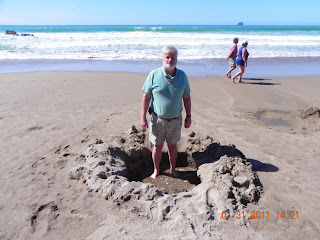On Wednesday, we signed up for a "dolphin" swim which is a four hour adventure in the Bay of Islands.
We met at the pier at 7:30 and met our captain and dolphin guide - Tammy and Loopie. (Sorry about the spelling, but that is how she pronounced it!)
There were about 10 of us total on the boat. After a short briefing, we headed out into the Bay searching for dolphins. There is also a competitor that offers the same type of experience, and both boats are friendly to each other and notify if they find anything. We were in search of bottle nose dolphins which can reach up to 12 feet long. They warned us several times that some days they don't even see a dolphin let alone swim with them. This whole activity is governed by the Department of Commerce and there are strict rules. If dolphins are spotted, only three watercraft can be in the immediate area. If there are any juveniles among the adults, you cannot get in the water with them. Time in the water is limited. There was a German couple on board with us that had gone out the day before, spent four hours looking for dolphins, and didn't see one. The company we were with has a guarantee, you can come back free if you don't see any or get to swim with any dolphins.
After looking for about a half hour, the competitor boat called us and told us they had spotted a "pod" of dolphins. We could see the bright yellow boat so we headed that way.
Our "dolphin" boat.
On board our boat.
"I want to swim with the dolphins"
After reaching the other boat, we could see the pod of dolphins. If you click on this picture, you can see one jumping out of the water.
Soon, there were several swimming near and under our boat. Our boat is a "jet" boat
so you don't have to worry about propellers hitting the dolphins.
There was space on the front of our boat where you could lay down with your face within
about a foot of the water. You could see the dolphins swimming right below the surface of the
water and then they would surface.
This was our competitors boat, much larger than ours, but ours so much closer to the water, and had fewer people on it. We could see the dolphins at a much closer range.
We followed the dolphins around for about a half an hour. They kept telling us that
the dolphins were acting a bit strange, and they might be communicating with another
"pod" somewhere in the Bay. They told us to get ready to go in the water, within seconds I
was ready to go!
All of a sudden, they yelled, ok - get in the water! I was the first one in.
They had given us fins and a mask and snorkel. Within two minutes of being in the water,
I had multiple dolphins swimming within six inches of me. They told us do not "touch".
I could have easily reached out on touched on, but I played by the rules.
It was interesting to see all the marks on the skin of the dolphins, made by other dolphins
and rubbing up against boats and rocks.
I would spin around in a circle and the dolphins would swim around looking at me (within inches)
It was amazing that they would be so close, but never touched me. At times they would swim right
below me, just missing my legs and fins.
That's me just to the right of this large dolphin. It was better to keep your face
in the water, there were so many around us. We were told that there were 20 to 25
dolphins in this pod.
Here's a close up of the last picture. You can see just how large this
dolphin was compared to me.
We were called out of the water about 20 minutes. Needless to say,
it was an amazing experience. Remember, these are wild dolphins.
We spent the remainder of the time looking at the various islands in the Bay of Islands,
and stopped at one for break.
After we got back, we had lunch near our hotel. A Japanese woman who was staying at our
hostel, and who had also been on the dolphin boat joined us for lunch. She was very interesting, told us
she taught Japanese to Chinese workers who were working in Japan. She also taught flower arranging
and taught Japanese girls how to properly wear a kimono.
As we were getting ready to go to dinner, we saw Nicole again, she was also staying at our hostel.
We invited her dinner. We were having dinner at the RSA (Returned Serviceman's Club) where
Reg is a member, so we invited her to come with us. She is a native of Belgium, but has lived in France
for many years. She is a retired school teacher and now does community volunteer work. She travels a lot,
and speaks at least 6 languages, including English well enough that we had a great dinner
conversation with us. She had been on our bus tour the day before.




















